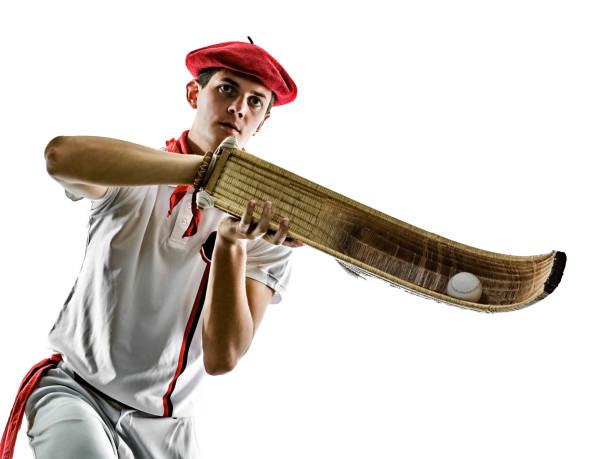Unveiling the Secrets of Jai-Alai: The World's Fastest Ball Game
In the realm of obscure yet exhilarating sports, Jai-Alai stands as a hidden gem, captivating audiences with its lightning-fast pace and unique blend of skill and danger. Originating from the Basque region of Spain and France, this centuries-old game has evolved into a thrilling spectacle that pushes human reflexes to their limits. As we delve into the world of Jai-Alai, prepare to discover the intricacies of a sport that combines elements of handball, lacrosse, and squash into a heart-pounding experience unlike any other.

The Basque Roots of Jai-Alai
Jai-Alai, which translates to “merry festival” in the Basque language, traces its origins back to the rural Basque communities of northern Spain and southwestern France. The sport evolved from a traditional handball game played against the walls of village churches, with players using their bare hands to propel a ball. Over time, this simple game transformed as players sought ways to increase the ball’s speed and reduce hand injuries.
The introduction of the cesta, the curved wicker basket used to catch and throw the pelota, marked a significant turning point in the sport’s development. This innovation, believed to have occurred in the mid-19th century, allowed players to achieve unprecedented velocities and opened up new possibilities for strategic play. The cesta’s design, which remains largely unchanged today, enabled players to harness centrifugal force, launching the pelota at blistering speeds.
As Jai-Alai gained popularity within Basque communities, it began to spread beyond its regional confines. The sport’s first professional match took place in 1798 in Marquina, Spain, marking the beginning of its journey from a local pastime to an international spectacle. By the early 20th century, Jai-Alai had made its way to Cuba, where it found a receptive audience and established a foothold in the Americas.
The Physics of Speed: Understanding Jai-Alai’s Extreme Velocity
At the heart of Jai-Alai’s appeal lies its breathtaking speed. The pelota, a ball made of layered rubber wrapped in goatskin, can reach velocities of up to 188 miles per hour – faster than any other ball in sports. This extreme speed is a result of several factors working in harmony: the unique properties of the pelota, the design of the cesta, and the skill of the players.
The pelota itself is a marvel of engineering, designed to maintain its shape and bounce despite the tremendous forces it endures. Its construction allows it to compress upon impact with the cesta or the court wall, storing energy that is then released as it rebounds. This characteristic, combined with the low air resistance of its smooth surface, enables the pelota to maintain much of its velocity throughout play.
The cesta, perhaps the most iconic element of Jai-Alai, plays a crucial role in achieving these extreme speeds. Its curved shape, typically 2 to 2.5 feet long, acts as an extension of the player’s arm, creating a larger surface area for catching and throwing. The wicker construction provides flexibility, allowing the cesta to absorb some of the pelota’s energy upon catching, reducing the impact on the player’s hand and arm.
When a skilled player catches the pelota in the cesta, they can use a whip-like motion to accelerate the ball even further. This technique, known as the “rebote,” involves catching the pelota near the base of the cesta and using a quick rotation of the wrist and forearm to launch it forward. The combination of the player’s arm motion and the cesta’s curve creates a slingshot effect, imparting tremendous speed to the pelota.
Understanding the physics behind Jai-Alai’s speed helps appreciate the skill and precision required from players. They must not only generate these incredible velocities but also control the direction and spin of the pelota, all while anticipating their opponent’s moves in a fraction of a second.
The Jai-Alai Court: A Unique Arena for Speed and Strategy
The Jai-Alai court, known as the fronton, is a critical component of the sport, its design influencing gameplay and strategy. The standard fronton consists of three walls: the front wall, the back wall, and the side wall, with the fourth side open for spectators. This three-walled configuration creates a dynamic playing environment that rewards both power and finesse.
The front wall, typically made of granite or a similarly hard material, stands about 40 feet high and 50 feet wide. Players must hit the pelota against this wall, above a designated serve line, for their throw to be considered valid. The smooth, unyielding surface of the front wall allows the pelota to rebound with minimal loss of speed, maintaining the game’s fast pace.
The side wall, extending back from the front wall for about 150 feet, introduces an additional strategic element to the game. Players can use this wall to create difficult angles for their opponents, bouncing the pelota off it to change its trajectory unexpectedly. The ability to read and utilize the side wall effectively is a hallmark of skilled Jai-Alai players.
The back wall, typically slanted, serves multiple purposes. Its angle helps redirect the pelota back into play, preventing too many dead balls and maintaining the game’s flow. Additionally, the back wall can be used strategically by players to set up shots or catch opponents off-guard.
The playing area is divided into 14 numbered spaces, with lines marked on the floor. These spaces play a crucial role in scoring and positioning, with different point values assigned to shots landing in specific areas. This scoring system adds a layer of strategy to the raw speed and power of the game, rewarding accuracy as well as velocity.
The unique design of the fronton creates a three-dimensional playing field that demands constant spatial awareness from players. They must track the pelota’s position not just in terms of left and right, but also in terms of height and depth within the court. This complexity, combined with the extreme speeds involved, makes Jai-Alai one of the most challenging and exciting sports to play and watch.
The Art of the Cesta: Craftsmanship and Innovation
The cesta, the curved basket used to catch and throw the pelota, is more than just a piece of equipment – it’s a work of art that embodies centuries of craftsmanship and innovation. Each cesta is handmade, a process that requires skill, patience, and an intimate understanding of the game’s demands.
Traditionally, cestas are made from reeds harvested from riverbeds in Spain or France. These reeds are carefully selected for their flexibility and strength, essential qualities for withstanding the tremendous forces involved in Jai-Alai. The reeds are soaked, shaped, and woven together to form the basket’s distinctive curved shape.
The process of creating a cesta begins with the formation of the frame, typically made from Spanish chestnut wood. This frame provides the structural integrity needed to withstand the impact of catching and throwing the pelota at high speeds. The reed weaving is then meticulously done by hand, with each artisan bringing their own style and techniques to the process.
One of the most critical aspects of cesta construction is achieving the right balance between flexibility and rigidity. The basket must be flexible enough to absorb some of the pelota’s energy upon catching, reducing strain on the player’s arm. However, it must also be rigid enough to maintain its shape and provide a consistent throwing surface. This delicate balance is achieved through careful selection of materials and precise weaving techniques.
The dimensions and curvature of the cesta are carefully calibrated to suit individual players’ preferences and playing styles. Professional players often work closely with cesta makers to create custom baskets that complement their throwing technique and hand size. The length, depth, and curve of the cesta can all be adjusted to maximize a player’s performance.
In recent years, there have been attempts to introduce modern materials and manufacturing techniques to cesta production. Some manufacturers have experimented with carbon fiber and other high-tech materials to create lighter, more durable cestas. However, many players and purists still prefer the traditional handmade reed cestas, valuing their feel and connection to the sport’s heritage.
The art of cesta making is a prime example of how traditional craftsmanship continues to play a vital role in modern sports. In an age of mass-produced equipment, the handcrafted cesta stands as a testament to the enduring value of skill, artistry, and personalization in athletic gear.
Training for Jai-Alai: Developing Superhuman Reflexes
The extreme speed and complexity of Jai-Alai demand a unique set of physical and mental skills from its players. Training for this sport goes beyond mere physical fitness, requiring the development of lightning-fast reflexes, exceptional hand-eye coordination, and strategic thinking under pressure.
One of the fundamental aspects of Jai-Alai training is developing the ability to track and anticipate the pelota’s movement. Players spend countless hours practicing their catching technique, learning to position their cestas to absorb the pelota’s impact safely. This involves not just physical positioning but also training the eyes to pick up the ball’s trajectory in a split second.
Reaction time drills form a crucial part of a Jai-Alai player’s training regimen. These exercises often involve simulating game scenarios where players must respond to unpredictable stimuli as quickly as possible. Advanced training facilities may use high-speed cameras and motion tracking technology to analyze and improve players’ reaction times down to the millisecond.
Strength and conditioning play a vital role in preparing players for the physical demands of Jai-Alai. The sport requires explosive power, particularly in the arms and shoulders, to generate the force needed for high-speed throws. Players engage in specialized weightlifting routines designed to build functional strength without sacrificing flexibility or speed.
Cardiovascular endurance is another key focus of Jai-Alai training. Matches can be intensely demanding, with players covering significant distances on the court while maintaining peak performance. Interval training and sport-specific cardio drills help players build the stamina needed to compete at the highest level.
Mental preparation is equally important in Jai-Alai. Players must develop the ability to make split-second decisions under extreme pressure. Visualization techniques and mindfulness practices are often incorporated into training to help players maintain focus and clarity during matches.
Strategy and tactical understanding are honed through extensive video analysis and on-court drills. Players study their opponents’ tendencies, learn to read subtle cues in body language, and develop a deep understanding of court geometry to gain a competitive edge.
Injury prevention is a critical aspect of Jai-Alai training, given the sport’s high-impact nature. Players work with physiotherapists and biomechanics experts to develop proper throwing and catching techniques that minimize strain on the body. Flexibility and mobility exercises are emphasized to reduce the risk of injuries associated with the sport’s explosive movements.
The training regimen for Jai-Alai players exemplifies the intersection of traditional athletic preparation and cutting-edge sports science. As our understanding of human performance continues to evolve, so too do the methods used to prepare athletes for this demanding and exhilarating sport.
The Global Reach of Jai-Alai: From Basque Country to the World
While Jai-Alai remains deeply rooted in Basque culture, its appeal has spread far beyond its original borders, creating a unique global footprint. The sport’s journey from rural pastime to international spectacle offers a fascinating glimpse into the ways traditional games can adapt and thrive in diverse cultural contexts.
Jai-Alai’s first major expansion occurred in the early 20th century when it was introduced to Cuba. The sport quickly gained popularity on the island, with the first professional fronton opening in Havana in 1901. From Cuba, Jai-Alai spread to other parts of Latin America, finding particular success in Mexico, Venezuela, and Brazil. Each of these countries developed its own Jai-Alai culture, with local variations in playing style and spectator traditions.
In the United States, Jai-Alai found a receptive audience in Florida, where it was introduced in the 1920s. The sport’s fast pace and the opportunity for legal gambling made it a popular attraction, particularly in Miami. At its peak in the 1970s and 1980s, Florida boasted multiple Jai-Alai frontons drawing large crowds and generating significant revenue.
Jai-Alai’s expansion wasn’t limited to the Americas. The sport also found footholds in parts of Asia, with professional frontons established in the Philippines and Macau. These Asian outposts of Jai-Alai developed their own unique characteristics, blending the sport’s Basque origins with local cultural influences.
Despite its global spread, Jai-Alai has faced challenges in maintaining its popularity outside of its traditional strongholds. In the United States, for example, the sport has seen a decline in recent decades, with many frontons closing due to changing entertainment preferences and gambling laws. However, efforts are underway to revitalize interest in the sport, including attempts to modernize its presentation and appeal to younger audiences.
In the Basque Country, Jai-Alai remains an integral part of cultural identity. The region hosts numerous tournaments and festivals centered around the sport, attracting players and spectators from around the world. These events serve not only as athletic competitions but also as celebrations of Basque heritage and tradition.
The global Jai-Alai community, though smaller than in its heyday, remains passionate and dedicated. International tournaments bring together players from different countries, fostering a sense of shared heritage and competition. Social media and online platforms have also played a role in connecting Jai-Alai enthusiasts worldwide, allowing for the exchange of techniques, stories, and cultural perspectives.
As Jai-Alai continues to evolve in the 21st century, it faces the challenge of balancing tradition with innovation. Efforts to modernize the sport, such as introducing new technologies for spectator engagement or adapting rules for televised matches, must be carefully weighed against preserving the core elements that make Jai-Alai unique.
The global journey of Jai-Alai serves as a testament to the universal appeal of sporting excellence and cultural exchange. While its future as a mainstream spectator sport may be uncertain in some regions, its continued practice and evolution ensure that this fascinating game will continue to captivate and inspire for generations to come.
The Future of Jai-Alai: Challenges and Opportunities
As Jai-Alai enters its third century as a professional sport, it faces a complex landscape of challenges and opportunities. The future of this unique and exhilarating game will depend on its ability to adapt to changing societal trends while maintaining the core elements that make it special.
One of the primary challenges facing Jai-Alai is the need to attract and retain a new generation of players and fans. In many regions where the sport once thrived, interest has waned as younger audiences gravitate towards more mainstream sports or digital entertainment. To address this, Jai-Alai organizations are exploring innovative ways to showcase the sport’s excitement and skill.
Technology is playing an increasingly important role in efforts to revitalize Jai-Alai. Virtual reality and augmented reality applications are being developed to give fans immersive experiences of the game, potentially reaching audiences far beyond traditional frontons. These technologies could also be used in training, allowing players to practice and analyze their techniques in virtual environments.
The integration of data analytics and artificial intelligence into Jai-Alai strategy and training represents another frontier for the sport. Advanced statistical analysis could provide new insights into player performance and game dynamics, potentially revolutionizing how the sport is played and coached.
Efforts are also underway to make Jai-Alai more accessible to amateur players. While the professional game requires specialized equipment and facilities, simplified versions of the sport are being developed for recreational play. These adaptations aim to introduce the fundamental skills and excitement of Jai-Alai to a wider audience, potentially sparking renewed interest in the full version of the game.
The globalization of sports media presents both challenges and opportunities for Jai-Alai. While competing for attention in a crowded media landscape is difficult, digital platforms offer new ways to reach niche audiences passionate about unique sports. Streaming services and social media could play a crucial role in showcasing Jai-Alai to a global audience, potentially rekindling interest in regions where the sport has declined.
Environmental sustainability is another area where Jai-Alai may need to evolve. The traditional materials used in equipment manufacturing, particularly for cestas, may face scrutiny as awareness of environmental issues grows. Innovations in sustainable materials and manufacturing processes could help ensure the sport’s long-term viability while appealing to environmentally conscious audiences.
The preservation of Jai-Alai’s cultural heritage remains a priority, particularly in the Basque region. Efforts to have the sport recognized by UNESCO as an Intangible Cultural Heritage could help raise its profile and ensure its continuation as a living tradition. This recognition could also open up new avenues for cultural tourism centered around Jai-Alai.
As with many traditional sports, Jai-Alai must navigate the complex world of sports betting and integrity. While gambling has historically been a significant part of the Jai-Alai experience in some regions, ensuring the sport’s integrity in the face of modern betting practices is crucial for maintaining public trust and interest.
The future of Jai-Alai will likely involve a del




